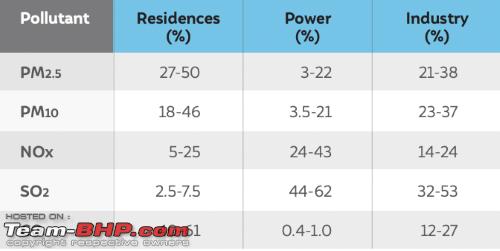New ICE automobiles alone cannot shoulder the entire burden of pollution reduction.
BHPian Mustang Sammy recently shared this with other enthusiasts.
The GoI continues to tighten emissions norms every year, including and especially for diesel engines. However, pollution continues to worsen, and we see evidence of it in the form of:
- Uncontrolled burning of refuse, leaves, and agricultural waste. Plumes of smoke emanate from various corners of our cities and villages every day.
- Industries emit noxious fumes without any consequence. Anyone who has lived in certain parts of Navi Mumbai can testify to this.
- Lax enforcement of PUC norms especially on commercial and government vehicles. Every day I see trucks, tempos, auto rickshaws, and buses (especially Maharashtra State Road Transport vehicles) belching clouds of black and gray smoke into the air.
- Semi-urban and rural areas also suffer from poor air quality. A recent weekend spent at a rural resort was sufficient to reinforce the sad reality of smoky and unclean air far away from urban population centers.
A cursory online search on contributors to our poor air quality shows a large spread in data, and the numbers for agricultural waste burning appear suspiciously low.

Source: Wikipedia



From the above data and real-world observations, it seems clear that:
- New ICE automobiles alone cannot shoulder the entire burden of pollution reduction. There is no point in mandating strict emissions norms on cars when commercial vehicles that run far more than cars and scooters are allowed to pollute at will (and these are egregiously high levels – you can smell the soot and unburnt fuel coming from the exhaust). Is it so easy to fake passing PUC results?
- Strict enforcement of existing norms is a must, including and especially cracking down on industrial pollution.
- The transition to clean burning fuels for home use is long overdue and is finally getting the priority it deserves.
- Adopting clean electricity is massively important, especially if we are to transition away from ICE to EVs. Setting up coal-burning plants to supply power for EVs is just transferring pollution away from urban to rural areas. The intermittency of Solar and wind power means that nuclear power HAS to be considered in any serious effort toward decarbonization.
Till then, mask up and keep your windows closed
Here’s what BHPian Simple_car had to say on the matter:
Industrial pollution is overrated in the more developed parts of India. The industries (except for small MSMEs) have become far more aware, and it’s getting difficult to get clearances without installing good infrastructure (apart from the usual govt demands). The biggest culprits of industrial pollution (if one were to categorize industry-wise) would be chemicals/plastics, fertilizers, mining and construction. I steer clear of these areas by a long mile. Other industries are surprisingly following international norms.
The problem of Navi Mumbai and Mumbai is the unabated construction and the wilful negligence of the authorities and builders/contractors who have no regard for the even basic measures that need to be enforced. Honestly, the usual reasons cited (cost of construction will increase significantly) are bull shit (Mumbai is one of the cheaper places to procure construction materials in the country). There are only 2 reasons for not wanting to follow basic measures (especially pertaining to air quality): they can, and systemic corruption.
I recently had to undertake a construction project, and we had a very hard time getting the contractors to follow basic measures (even at our own cost). And we hired very well-reputed contractors. (who do international projects for companies that are known for their higher standards).
Another recent experience… the road to our locality was finally relaid and concretized after a gap of nearly 15 years. I found that the contractor was wilfully using sub-par and lower-spec materials throughout. When we questioned him, his arrogance and the answers clearly indicated that they simply do not care, and the authorities won’t take any action (since they themselves are hand in glove). Not surprising, but I can assure you that our locality will soon be generating enough debris due to the subpar work done.
The only way I see out of this mess is we need to really need to reign in the construction industry and the associated govt. bodies (central, state, and local). Citizen initiatives in Mumbai at least are failing since there is an informal understanding within the govt, the babudom, and the contractors that no action will be taken. Court battles… less said the better (not everyone can afford big-shot guys and frankly it is a time-consuming process).
Air quality issues require basics to be followed (and these do not add a significant cost to the projects). We will need the citizens to start getting hands-on, and really get the authorities to become accountable.
Here’s what BHPian fhdowntheline had to say on the matter:
Too much construction in the country. I am beginning to wonder how much infrastructure is essential and how much is just fancy. NHAI is ripping apart the landscape to change the alignment of the Mumbai-Pune expressway such that about 20 minutes of driving time is shortened. If there ever was a Marie Antoinette moment. Then you have a Pune-Nashik expressway planned AND a high-speed rail link. Why? On the other hand, they still don’t have any handle on the Mumbai-Goa expressway.
It’s hardly a wonder that air pollution is rising across the country. Pune was never a ‘highly polluted’ city. Now it has also entered the ranks. Every 4th heavy vehicle in the suburbs is either a concrete mixer or a dumper or a JCB.
Check out BHPian comments for more insights and information.







